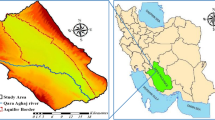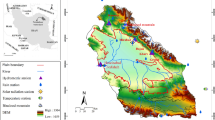Abstract
Improper extraction of groundwater resources has led to a sharp decline in the water level of aquifers. To achieve sustainable management of groundwater, it is very important to simulate the amount of recharging an aquifer by considering the physical properties of the relevant basin (such as soil properties, land use, irrigation, climate data and unsaturated layer). In the present study, a groundwater modeling was accomplished to predict the recharge rate under the conditions of climate change and irrigation reduction. Meteorological parameters in the next period (2021–2050) were simulated by ten climate change models (GCMs) under emission scenarios. The combination of SWAT and MODFLOW models was also used to predict the groundwater recharge rate. The results of forecasting climatic parameters in the next period (2021–2050) indicated that the temperature will increase (0.66–1.68 °C) while the precipitation will decrease (4–14%). The recharge rate modeling revealed that recharge values in heavy soils are less estimated compared to that of the light soils of the region. Also, the average recharge rate of the whole aquifer in the next period under the RCP4.5 and RCP8.5 scenarios will decrease by 23 and 34%, respectively. The simulation of reducing the irrigation requirements on the recharging rate indicated that with a 30% reduction of irrigation, the average recharging rate of the whole plain will decrease by 12%. Therefore, it is recommended to apply policies to decrease irrigation requirements, such as the development of pressurized irrigation systems and the cultivation of low-consumption plants, to help balance the aquifer.












Similar content being viewed by others
References
Abbasi F, Sohrab F, Abbasi N (2017) Evaluation of irrigation efficiencies in Iran. Irrig Drain Struct Eng Res 17(67):113–120. https://doi.org/10.22092/ARIDSE.2017.109617
Abbaspour KC (2011) SWAT-CUP2: SWAT calibration and uncertainty programs manual version 2. Eawag. swiss federal institute of aquatic science and technology, department of systems analysis. Integrated Assessment and Modeling (SIAM), Duebendorf, Switzerland, p 106
Abbaspour KC, Rouholahnejad E, Vaghefi S, Srinivasan R, Yang H, Kløve B (2015) A continental-scale hydrology and water quality model for Europe: calibration and uncertainty of a high-resolution large-scale SWAT model. J Hydrol 524:733–752. https://doi.org/10.1016/j.jhydrol.2015.03.027
Adopted I (2014) Climate change 2014. Synthesis report. IPCC: Geneva, Szwitzerland
Al-Safi HIJ, Sarukkalige PR (2020) The application of conceptual modelling to assess the impacts of future climate change on the hydrological response of the Harvey River catchment. J Hydro-Environ Res 28:22–33. https://doi.org/10.1016/j.jher.2018.01.006
Anonymous (2015) Studies of the second phase of the irrigation and drainage network Mirza Shirazi dam (Kavar plain). Regional water company of Fars,Technical Report, Iran
Anonymous (2018) Statistics and performance Agriculture section Fars province. Agricultural organization of Fars, Technical Report, Iran
Arnold JG, Srinivasan R, Muttiah RS, Williams JR (1998) Large area hydrologic modeling and assessment part I: model development 1. J Am Water Resour Assoc 34(1):73–89. https://doi.org/10.1111/j.1752-1688.1998.tb05961.x
Azeref BG, Bushira KM (2020) Numerical groundwater flow modeling of the Kombolcha catchment northern Ethiopia. Model Earth Syst Environ 6(2):1233–1244. https://doi.org/10.1007/s40808-020-00753-6
Bushira KM, Hernandez JR, Sheng Z (2017) Surface and groundwater flow modeling for calibrating steady state using MODFLOW in Colorado River Delta, Baja California Mexico. Model Earth Syst Environ 3(2):815–824. https://doi.org/10.1007/s40808-017-0337-5
Chaemiso SE, Abebe A, Pingale SM (2016) Assessment of the impact of climate change on surface hydrological processes using SWAT: a case study of Omo-Gibe river basin Ethiopia. Model Earth Syst Environ 2(4):1–15. https://doi.org/10.1007/s40808-016-0257-9
Chitsazan M, Rahmani G, Ghafoury H (2020) Investigation of subsidence phenomenon and impact of groundwater level drop on alluvial aquifer, case study: Damaneh-Daran plain in west of Isfahan province Iran. Model Earth Syst Environ 6(2):1145–1161. https://doi.org/10.1007/s40808-020-00747-4
Chunn D, Faramarzi M, Smerdon B, Alessi DS (2019) Application of an integrated SWAT–MODFLOW model to evaluate potential impacts of climate change and water withdrawals on groundwater–surface water interactions in West-Central Alberta. Water 11(1):110. https://doi.org/10.3390/w11010110
Doherty J, Brebber L, Whyte P (1994) PEST: model-independent parameter estimation. Watermark Comput Corinda Aust 122:336
Etemadi H, Samadi S, Sharifikia M (2014) Uncertainty analysis of statistical downscaling models using general circulation model over an international wetland. Clim Dyn 42(11–12):2899–2920. https://doi.org/10.1007/s00382-013-1855-0
Farhadi S, Nikoo MR, Rakhshandehroo GR, Akhbari M, Alizadeh MR (2016) An agent-based-nash modeling framework for sustainable groundwater management: a case study. Agri Water Manag 177:348–358. https://doi.org/10.1016/j.agwat.2016.08.018
Fleckenstein JH, Krause S, Hannah DM, Boano F (2010) Groundwater-surface water interactions: new methods and models to improve understanding of processes and dynamics. Adv Water Resour 33(11):1291–1295. https://doi.org/10.1016/j.advwatres.2010.09.011
Gilfedder M, Rassam DW, Stenson MP, Jolly ID, Walker GR, Littleboy M (2012) Incorporating land-use changes and surface–groundwater interactions in a simple catchment water yield model. Environ Model Softw 38:62–73. https://doi.org/10.1016/j.envsoft.2012.05.005
Gohari A, Eslamian S, Abedi-Koupaei J, Bavani AM, Wang D, Madani K (2013) Climate change impacts on crop production in Iran’s Zayandeh-Rud River Basin. Sci Total Environ 442:405–419. https://doi.org/10.1016/j.scitotenv.2012.10.029
Goodarzi M, Abedi-Koupai J, Heidarpour M, Safavi HR (2016) Evaluation of the effects of climate change on groundwater recharge using a hybrid method. Water Resour Manag 30(1):133–148. https://doi.org/10.1007/s11269-015-1150-4
Guzman JA, Moriasi D, Gowda PH, Steiner JL, Starks P, Arnold JG, Srinivasan R (2015) A model integration framework for linking SWAT and MODFLOW. Environ Model Softw 73:103–116. https://doi.org/10.1016/j.envsoft.2015.08.011
Gyamfi C, Ndambuki JM, Anornu GK, Kifanyi GE (2017) Groundwater recharge modelling in a large scale basin: an example using the SWAT hydrologic model. Model Earth Syst Environ 3(4):1361–1369. https://doi.org/10.1007/s40808-017-0383-z
Haidu I, Nistor MM (2020) Long-term effect of climate change on groundwater recharge in the Grand Est region of France. Meteorol Appl 27(1):e1796. https://doi.org/10.1002/met.1796
Harbaugh AW (2005) MODFLOW-2005, the US Geological Survey modular ground-water model: the ground-water flow process. US Department of the Interior, vol. 6. US Geological Survey Reston, VA, USA
Izady A, Davary K, Alizadeh A, Ziaei A, Akhavan S, Alipoor A, Joodavi A, Brusseau M (2015) Groundwater conceptualization and modeling using distributed SWAT-based recharge for the semi-arid agricultural Neishaboor plain Iran. Hydrogeol J 23(1):47–68. https://doi.org/10.1007/s10040-014-1219-9
Izady A, Joodavi A, Ansarian M, Shafiei M, Majidi M, Davary K, Ziaei AN, Ansari H, Nikoo M, Al-Maktoumi A (2022) A scenario-based coupled SWAT-MODFLOW decision support system for advanced water resource management. J Hydroinform 24(1):56–77. https://doi.org/10.2166/hydro.2021.081
Kashef AI (1986) Groundwater engineering. McGraw-Hill, Newyork
Khajeh S, Paimozd S, Moghaddasi M (2017) Assessing the impact of climate changes on hydrological drought based on reservoir performance indices (case study: ZayandehRud River basin, Iran). Water Resour Manag 31(9):2595–2610. https://doi.org/10.1007/s11269-017-1642-5
Kim NW, Chung IM, Won YS, Arnold JG (2008) Development and application of the integrated SWAT–MODFLOW model. J Hydrol 356(1–2):1–16. https://doi.org/10.1016/j.jhydrol.2008.02.024
King LM, Irwin S, Sarwar R, McLeod AIA, Simonovic SP (2012) The effects of climate change on extreme precipitation events in the Upper Thames River Basin: a comparison of downscaling approaches. Can Water Resour J 37(3):253–274. https://doi.org/10.4296/cwrj2011-938
Kouhestani S, Eslamian SS, Abedi-Koupai J, Besalatpour AA (2016) Projection of climate change impacts on precipitation using soft-computing techniques: a case study in Zayandeh-rud Basin Iran. Glob Planet Change 144:158–170. https://doi.org/10.1016/j.gloplacha.2016.07.013
Liu L, Cui Y, Luo Y (2013) Integrated modeling of conjunctive water use in a canal-well irrigation district in the lower Yellow River basin China. J Irrig Drain Eng 139(9):775–784. https://doi.org/10.1061/(ASCE)IR.1943-4774.0000620
McDonald MG, Harbaugh AW (1988) A modular three-dimensional finite-difference ground-water flow model. Techniques of Water Resources Investigations, U.S. Geological Survey, Book 6, Reston, Virginia
Mishra BK, Regmi RK, Masago Y, Fukushi K, Kumar P, Saraswat C (2017) Assessment of Bagmati river pollution in Kathmandu Valley: scenario-based modeling and analysis for sustainable urban development. Sustain Water Qual Ecol 9:67–77. https://doi.org/10.1016/j.swaqe.2017.06.001
Neitsch SL, Arnold JG, Kiniry JR, Williams JR (2011) Soil and water assessment tool theoretical documentation version 2009, Texas Water Resources Institute, Technical Report, 406:647
Rafiee MR, Moazed H, Boroomandnasab AA, Gaemi S (2016) FAO-56 method for estimating evapotranspiration and crop coefficients of eggplant in greenhouse and outdoor conditions. Irrig Sci Eng 39(2):59–77. https://doi.org/10.1016/j.jare.2016.02.005
Raposo JR, Dafonte J, Molinero J (2013) Assessing the impact of future climate change on groundwater recharge in Galicia-Costa Spain. Hydrogeol J 21(2):459–479. https://doi.org/10.1007/s10040-012-0922-7
Sepaskhah AR, Fooladmand HR (2004) A computer model for design of microcatchment water harvesting systems for rain-fed vineyard. Agric Water Manag 64(3):213–232. https://doi.org/10.1016/S0378-3774(03)00197-5
Sivakumar M, Das H, Brunini O (2005) Impacts of present and future climate variability and change on agriculture and forestry in the arid and semi-arid tropics. Clim Change 70:31–72. https://doi.org/10.1007/1-4020-4166-7_4
Wable PS, Chowdary V, Panda S, Adamala S, Jha C (2021) Potential and net recharge assessment in paddy dominated Hirakud irrigation command of eastern India using water balance and geospatial approaches. Environ Dev Sustain 23(7):10869–10891. https://doi.org/10.1007/s10668-020-01092-3
Yidana SM, Chegbeleh LP (2013) The hydraulic conductivity field and groundwater flow in the unconfined aquifer system of the Keta Strip, Ghana. J Afr Earth Sci 86:45–52. https://doi.org/10.1016/j.jafrearsci.2013.06.009
Yifru BA, Chung IM, Kim MG, Chang SW (2020) Assessment of groundwater recharge in agro-urban watersheds using integrated SWAT-MODFLOW model. Sustainability 12(16):6593. https://doi.org/10.3390/su12166593
Zarei M, Ghazavi R, Vali A, Abdollahi K (2016) Estimating groundwater recharge, evapotranspiration and surface runoff using land-use data: a case study in northeast Iran. Biol Forum Int J 8(2):196–202
Acknowledgements
The authors sincerely appreciate the experts of the Regional Water Company, and the Agricultural Organization of Fars for providing all the required information.
Funding
The authors declare that no funds, grants, or other support were received during the preparation of this manuscript.
Author information
Authors and Affiliations
Contributions
MKS performed conceptualization; writing original draft; data analysis; methodology; software; and validation. JA-K performed supervision; conceptualization; methodology; validation; visualization; investigation; writing, reviewing and editing of the manuscript. SSE performed supervision; reviewing of the manuscript. SARG performed investigation; reviewing of the manuscript.
Corresponding author
Ethics declarations
Conflict of interest
The authors have no relevant financial or non-financial interests to disclose.
Additional information
Publisher's Note
Springer Nature remains neutral with regard to jurisdictional claims in published maps and institutional affiliations.
Rights and permissions
Springer Nature or its licensor (e.g. a society or other partner) holds exclusive rights to this article under a publishing agreement with the author(s) or other rightsholder(s); author self-archiving of the accepted manuscript version of this article is solely governed by the terms of such publishing agreement and applicable law.
About this article
Cite this article
Shaabani, M.K., Abedi-Koupai, J., Eslamian, S.S. et al. Simulation of the effects of climate change and reduce irrigation requirements on groundwater recharge using SWAT and MODFLOW models. Model. Earth Syst. Environ. 9, 1681–1693 (2023). https://doi.org/10.1007/s40808-022-01580-7
Received:
Accepted:
Published:
Issue Date:
DOI: https://doi.org/10.1007/s40808-022-01580-7




